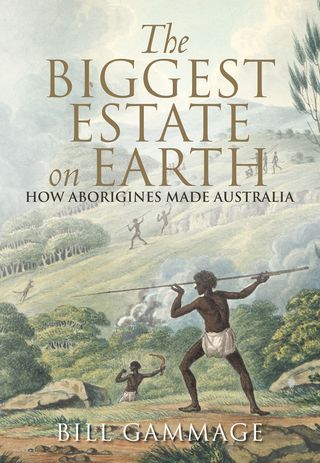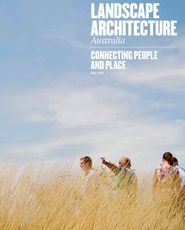
The Biggest Estate On Earth: How Aborigines Made Australia by Bill Gammage.
The Biggest Estate on Earth: How Aborigines Made Australia, is a social and cultural history that has won numerous awards including the Prize for Australian History in the 2012 Prime Minister’s Literary Awards. Author Bill Gammage is a historian and adjunct professor in the Humanities Research Centre at the Australian National University who is best known for the book The Broken Years: Australian Soldiers in the Great War.
The main thesis of The Biggest Estate on Earth is that in 1788, the time of Australia’s first contact with European settlers, the Australian landscape was constructed rather than natural; it was an extensive web of managed ecologies that created the biggest estate on earth. This book is an exceptional account of how Aboriginal people managed their land, “what they did, and why.” Gammage’s rigorous, decade-long investigation stretches across the continent and is drawn from over 1,500 references.
The Biggest Estate on Earth continues a tradition of rethinking; from 1960s archaeology, which pushed back human occupation in Australia from 10,000 years to 50,000 years, through to the 1970s and 1980s when “historians recast the national story and ended what had been called the great Australian silence”; to developing radically different views of Aboriginal land management and the use of fire to alter vegetation patterns [page xxi]. Gammage’s forensic examination of evidence combines a reportage style with rich descriptive passages that compare his firsthand reading of the landscape with those of the eighteenth-century settlers. Depicting landscapes unchanged by Europeans, Gammage challenges the assumption that the romanticizing by early colonial artists renders their accounts inaccurate: “artists were photographers of their day,” so why would they invent “a landscape that viewers might know was false, when the original was so novel”? [page 19]
The biggest estate on earth combined the management of complex ecosystems with the look of the land, and early observations noted “absences”1 right across Australia, describing it as a “country always more open than is natural” with beautiful ‘park-like’” scenes [page 41]. It is a story of universal land stewardship, of active, planned and precise local action that stretched across a continent. Gammage describes this local management of diverse ecologies as an “impressive achievement,” but it is for him “the making from it a single estate [that] was a breath-taking leap of imagination.” In Invasion, the final chapter of the book, Gammage explores what might be considered the greatest irony of the sophistication of Aboriginal land management – that “people made the land beautiful, but settlers took it because it was useful … the more carefully they made the land, the more likely settlers were to take it” [page 95].
The literary merit of this book is in Gammage’s collation of extensive and compelling evidence and an unwavering ambition for us to imagine a more sustainable future founded by challenging the assumptions of the past. The extensive referencing talks to the overwhelming evidence in support of his argument, and while at times a little distracting, the descriptions remain engaging, encouraging further enquiry and consideration of the available evidence. The Biggest Estate on Earth is an insightful and intelligent provocation. Gammage’s exploration of art, history, nature and lore is at times reminiscent of that other weighty landscape tome, Simon Schama’s Landscape and Memory.
As recently as July 2000 Philip Ruddock, the then Minister for Immigration and Reconciliation, commented in The Washington Post that “we’re dealing with an indigenous population that had little contact with the rest of the world. We are dealing with people who were essentially hunter-gatherers. They didn’t have chariots. I don’t think they invented the wheel.”2 What Ruddock failed to appreciate is that while, as Gammage argues, the Dreaming decrees how people must act, it did “not stifle human curiosity.” If the Dreaming “conceives an unchangeable universe, hence free of time,” then in that context “innovation and creativity become means not ends” [pages 123, 124].
Gammage’s research demands more of us as readers, asking us to rethink certain attitudes and beliefs by asserting that “country was not property if anything it owned [the people],” [page 142]; that “people today think of what animals need. In 1788 people thought of what animals prefer,” [page 211] and that “if terra nullius exists anywhere in our country, it was made by Europeans” [page 323]. In his postscript he challenges his detractors, describing how “in the physical sciences experiments are repeated and laws established … A thing is objectively true if a test can be repeated with the same result. A valid test puts an end to speculation. But, a historian would say, it does not put an end to assumption” [page 325]. If the great Australian silence has stopped, then now the assumptions must end.
Bill Gammage, Allen & Unwin, 2012, 484 pages. RRP $39.99.
Read Shaneen Fantin’s review of The Biggest Estate on Earth for Architecture Australia July/Aug 2013.
1 Big Ideas, ABC Radio National, abc.net.au/radionational/programs/bigideas/bill-gammage-photo/4579324 (accessed 12 May 2013).
2 “Pressure for Reconciliation Minister to Resign over Aboriginal Disadvantage Comment,” AM program on ABC Local Radio, abc.net.au/am/stories/s195809.htm (accessed 12 May 2013).
Source

Discussion
Published online: 14 Aug 2013
Words:
Claire Martin
Issue
Landscape Architecture Australia, August 2013














